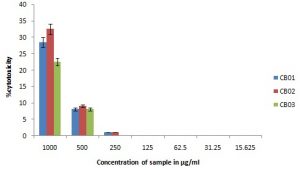DESIGN AND DEVELOPMENT OF POLYHERBAL BASED CREAM FORMULATION WITH ANTI-SKIN AGEING BENEFITS
HTML Full TextDESIGN AND DEVELOPMENT OF POLYHERBAL BASED CREAM FORMULATION WITH ANTI-SKIN AGEING BENEFITS
R. Dilmel Krishnan*1, M. Vijaya Kumar 1, R. Sandeep Varma 1, U.V. Babu 1 and S.P. Dhanabal 2
R & D Center 1, The Himalaya Drug Company, Makali, Bangalore - 562162, Karnataka, India.
The JSS college of Pharmacy 2, Rocklands, Ooty - 643001, Tamil Nadu, India.
ABSTRACT: The objective of this study was to design and develop poly herbal cream based formulation using combination of aqueous poly herbal extracts of Rosa damascena flowers (RDW), Clerodendrum paniculatum leaves (CPW), Murraya koengii leaves (MKW) and Annona squamosa leaves (ASW) which increased the collagen content in human dermal fibroblast thereby showing skin anti-ageing property. The presence of collagen –I content in human dermal fibroblast (HDF) cells was confirmed by ELISA. The three different ratios of plant extracts blends (CB 01, CB02 and CB03) were prepared. The extract blend (CB03)in particular ratio (2:2:1:1) of the above individual plant extracts respectively showed 18.65 ± 0.061ng/ml (p < 0.05) of collagen-I as compared to 16.53 ± 0.064 of standard ascorbic acid (ng/ml) at 100µg/ml. Five different carrier cream base was developed (F-1, F-2, F-3, F-4 and F-5. F2 (PHY/AAC/01) formulation was finalised with (CB03) active blend (PHY/AAC/02) which showed 17.53 ± 0.011ng/ml for collagen-I content in HDF cells. The in vitro safety of (CB 03) and (PHY/AAC/02) was measured by neutral red uptake assay using NIH3T3 cell lines, and the CTC50 value of (CB03) and (PHY/AAC/02) was above 1000 μg/mL for 24-hour study period. The final formulations were studied for rheological studies and thermal stability was confirmed on basis of physicochemical properties like pH and viscosity. The study results for formulation (PHY/AAC/02) containing (CB 03) was found to upregulate Collagen-I gene expression compared to control and standard (market sample) which helps prevents skin ageing and promoted building of collagen matrix.
| Keywords: |
Collagen, Skin ageing, Annona squamosa, Rosa damascena, Murraya koengii, Clerodendrum paniculatum
INTRODUCTION: The skin acts as major defense to internal organs of the body from external environment. It consists of three main layers: the epidermis, the dermis and the subcutaneous tissue. The epidermis is mainly composed of keratinocytes, which protects the skin from external environment 1.
Healthy skin is desired by all human beings and people spend lots of money to prevent premature ageing. The glowing radiant skin emphasizes major aspects of good health and well-being 2.
Ageing is impairment of skin barrier function, leading to a decrease in sebum content, skin pH, stratum corneum hydration and trans-epidermal water loss 3. There are two main processes that cause skin ageing: Extrinsic and Intrinsic. Extrinsic ageing is characterized by environmental factors such as Sun exposure, pollution, smoking, and poor nutrition. Intrinsic ageing is caused by the genetic factors and is time dependent. Extrinsic ageing skin is major cause of concern as it is more prevalent on skin characterized by wrinkles, laxity, brown spots, and uneven pigmentation 4.
There are different types of fibrous proteins present in skin of which collagen plays a major role. Collagen is natural protein present in our connective tissue which plays a major role in maintaining skin vitality and elasticity. It forms cross linking network of fibroblasts, new granulation tissue and epithelium at the damaged skin. Collagens are of 16 different types of which Collagen I, II and III form 80% of the total collagen content in body. Collagen I and III are present in skin tendons, cartilage and reticular fibers which are mainly suitable for anti-ageing activity 5.
It has been reported that the process of skin rejuvenation can be stimulated by different plant extracts rich in biomarkers, such as flavonoids, triterpenes, alkaloids, tannins and other bio-molecules 5. Collagen synthesis activity was performed for Veronica officinalis extract in vitro to determine the anti-wrinkle effect of formulated cream 6. Aloe vera, Vitis vinifera, Triticum sativum, Dioscorea villosa and Camelia sinensis can protect skin against wrinkle and other skin disorders 7. The present study focused on the anti-ageing potential of four selected plants namely Annona squamosa, Clerodendrum paniculatum, Murraya koenigii and Rosa damascena.
The Annona squamosa leaves (Family: Annonaceae) are used as folk medicine in treatment of wound in different parts of the world. The extracts of different species of Annona are reported for antioxidant activity by different in vitro assays like DPPH, nitric oxide, superoxide and lipid peroxidise 8. A. squamosa extract increases cellular proliferation in HD cultures and increases collagen 9. Clerodendrum paniculatum leaves extract (Family: Lamiaceae) is reported for treatment of skin ailments. The major constituents reported for C. Paniculatum are phenolics, steroids, flavonoids, terpenes and volatile oils 10.
Murraya koenigii leaves (Family: Rutaceae) are used as aromatic spice in India. M. koenigii is reported as antioxidants and proteosome activity 11. The leaves contain alkaloid which has reported for dual function of anti-ageing and anti-cholinesterase 12. Both fresh flower and spent flower extracts of Rosa damascena flowers (Family: Rosaceae) was reported for antioxidant activity. Major Biomarker isolated from flowers, petals and leaves of R. damascena are phenolic which is reported for antioxidant property 13. R. damascena flowers contain phenolic compounds like Gallic acid 14.
The present study was aimed to evaluate the unique poly-herbal formula for restoration of skin collagen and skin firmness. In order to support the use of this poly-herb extract blend formula as a new, natural product for skin vitality, it was investigated by in vitro assay of collagen content on human dermal fibroblast cells and confirmed by Collagen -I gene expression studies.
MATERIALS AND METHODS:
Materials:
Plant materials: The C. Paniculatum leaves (Batch number. NPD/137/2014), R. Damascena flowers (Batch number. NPD/686/2012) M. koengii leaves (Batch number. NPD/86/2014) and A. squamosa leaves (Batch number. NPD/85/2014), were purchased from a local market supplier and identified, as well as authenticated by a certified botanist, Department of Pharmacognosy, The Himalaya Drug Company (Bangalore, India). The individual plant materials were extracted at Phytochemistry department, R & D Centre, The Himalaya Drug Company (Bangalore, India).
In vitro Cell Culture Study Material: The cell culture experiments were performed using Human dermal fibroblast (HDF) and mouse embryo fibroblasts (NIH 3T3), which were obtained from the National Centre for Cell Science (NCCS; Pune, India). They were maintained in DMEM - high glucose (Sigma, Bangalore, India) with 10% fetal bovine serum, 1% antibiotic solution - penicillin (100 U/mL) and streptomycin (100 µg/mL) (Hi-Media), and 2.0 and 2.5 g/L sodium bicarbonate (Sigma) in 25cm2 polystyrene flask (Tarsons, Kolkata, India) under the atmosphere of 5% CO2 at 37 °C with 95% humidity.
Cream Formulation Excipients: The cream formulation was prepared using following excipients: carbopol 980 (Lubrizol USA), Cetyl alcohol (Croda, Mumbai, India), Cetostearyl alcohol (Croda, Mumbai India), Capryliccapric triglyceride (Subhash chemicals, Mumbai, India), Glycerine(Godrej industries, Mumbai, India), Isopropyl myristate (Croda, Mumbai, India), Stearic acid (Godrej industries, Mumbai, India), sodium hydroxide (SD Fine chemicals, Bangalore, India), Vitamin E (Merck limited, Mumbai, India), Xanthan gum (Zungbungler, USA).
Methods:
Preparation of Plant Extracts and Poly-herbal Blends: The individual plant materials were washed with fresh water, shade dried, and powdered in a pulveriser. The dried and powdered herb material (each 100 g) was extracted in herb to solvent ratio of 1:6 by stirring with 600 mL of water under hot extraction for 6 hr in a water bath. The concentration of extracts was done under vacuum using Rota vapor, Make- Buchi, Model- R 215V). Individual water extracts were obtained and based on in vitro activity, three different permutation ratios of extract blend were made which were labelled as (CB01), (CB02) and (CB03) based on their cyto-toxicity and collagen content assay. The extract yield is mentioned in Table 1.
TABLE 1: WATER EXTRACTIVE YIELDS OF SELECTED PLANTS
| S No. | Name of the plants | Part used | Extractive yield (%w/w) |
| 1 | Rosa damascena | Flowers | 2.76 |
| 2 | Clerodendrum paniculatum | Leaves | 24.24 |
| 3 | Murraya koengii | Leaves | 7.58 |
| 4 | Annona squamosa | Leaves | 18.37 |
(CB01) was made by blending the individual water extract in the ratio of 1:2:2:1 for R. damascena, C. paniculatum, M. koengii and A. squamosa respectively. (CB02) was made in the ratio of 1:1:2:2 for the above mentioned herbs and (CB03) was made in the ratio of 2:2:1:1 in order respectively. (CB01), (CB02) and (CB03) were checked for cyto-toxicity and collagen assay studies. Five different cream bases (F-1, F-2, F-3, F-4 and F-5) were developed and based on seven day stress study F-2 was finalized for further studies. F-2 was recorded as (PHY/AAC/01) and mentioned in all the subsequent experiments.
Preparation of Cream Formulation: Water phase consists of carbopol 980 and xanthan gum which was weighed accurately into separate vessel. It was dispersed in demineralized water under gentle mixing using stirrer in water bath. Similarly Oil phase which comprises of Cetyl alcohol, Cetostearyl alcohol, Caprylic capric triglycerides, Isopropyl myristate, Glyceryl monostearate and Stearic acid were weighed accurately in separate vessel, Both the phases were heated at 80 °C in water bath and when both the temperature were attained at 80 °C oil phase was transferred to water phase and homogenized for 30 minutes at 100 rpm. It was cooled at room temperature. Antioxidant, Vitamin E and preservative, Phenoxyethanol was added to the cream formulation. Cream was mixed well for 10 minutes. The five different formulas were selected to optimize viscosity, pH, and rheological studies like emulsion strength, thixo-tropicity and elasticity from lowest to highest concentration of emulsifiers, and gelling agents. Five different permutation combinations helped to optimize a single stable formula which was studied at 30 °C and 45 % RH and 45 °C and 75 % RH which is mentioned in Table 2.
TABLE 2: FORMULATION OF CREAM BASE WITH DIFFERENT PERMUTATION COMBINATION
| Formulations | |||||
| Ingredients (%) | F-1 | F-2 | F-3 | F-4 | F-5 |
| Carbopol 980 | 0.25 | 0.5 | 0.6 | 0.65 | 0.7 |
| Xanthan gum | 0 | 0.1 | 0.2 | 0.25 | 0.3 |
| Cetyl alcohol | 1 | 2 | 2.25 | 2.5 | 2.75 |
| Cetostearyl alcohol | 0.5 | 1 | 1.25 | 1.5 | 1.75 |
| Glyceryl monostearate | 1 | 2 | 2.25 | 2.5 | 2.75 |
| Stearic acid | 3.5 | 4 | 4.25 | 4.5 | 4.75 |
| Capryliccapric triglycerides | 1 | 2 | 2.25 | 2.5 | 2.75 |
| Isopropyl myristate | 1 | 2 | 2.25 | 2.5 | 2.75 |
| Water (demineralised) | 86.28 | 72.93 | 79.23 | 77.63 | 76.03 |
| Glycerine | 3 | 3 | 3 | 3 | 3 |
| Sodium hydroxide | 0.2 | 0.2 | 0.2 | 0.2 | 0.2 |
| Vitamin E acetate | 0.3 | 0.3 | 0.3 | 0.3 | 0.3 |
| Phenoxy ethanol | 0.9 | 0.9 | 0.9 | 0.9 | 0.9 |
| Perfume Make-soothing inde | 1.0 | 1.0 | 1.0 | 1.0 | 1.0 |
| Color-Make-1% Ponceau | 0.07 | 0.07 | 0.07 | 0.07 | 0.07 |
Cytotoxicity Assay: The Cytotoxic effect of poly-herbal extract blend and cream formula was determined by 3-(4, 5-dimethylthiazol-2-yl)-2,5-diphenyltetrazolium bromide (Sigma) MTT assay in HDF and NIH 3T3 cells. Both the cells (1 x 104 cells/mL) were cultured on a 96-well plate in a respective medium with different concentrations of poly-herbal extract and final cream formulation (1000-15.625 μg/mL) for 24 hours. The cells were added with 10 μL of MTT (5 mg/mL) to each well, followed by incubation for 4 hours at 37 °C. The supernatant was removed, and 100 μL of dimethyl sulfoxide (Merck) was added to each well to dissolve the Formazan product. Absorbance was determined at 540 nm spectrophotometrically using an ELISA reader (Synergy HT multi-detection micro plate reader). The CTC50 values of extract and cream formulation were calculated and the nontoxic concentrations were taken for the further experiment.
Collagen ELISA: Collagen-I ELISA kit was used for the quantitative measurements of collagen-I (Blue Gene Biotech, China) in cell supernatants human dermal fibroblast (HDF). After treatment with the test samples, HDF cells were incubated for 96 hr at 37 °C. The cells were harvested and the cell supernatant was used for ELISA. ELISA was carried out as per the instructions provided in the kit. The individual water extracts of A. squamosa (ASW), M. koengii (MKW), R. damascena (RDW), C. paniculatum (CPW) and extract blends-(CB 01), (CB 02) and (CB 03) was used for collagen content determination. The final formulation (PHY/AAC /02) containing best poly-herbal extract blend (CB 03) was also checked for collagen content determination. Color developed in proportion to the amount of collagen, was measured at 450 nm.
Semi Quantitative Polymerase Chain Reaction: The final formulation (PHY/AAC/02) containing extract blend (CB 03) showing good collagen-I content was selected for RT PCR. Total RNA was extracted from cells using TRI reagent (Sigma). The isolated RNA was quantified on 1% denaturing agarose gel. Total RNA and OligodT were used for cDNA synthesis by Reverse transcriptase. PCR
reactions were carried out using the specific primers for collagen type I and the operating conditions of PCR were as follows, initial denaturation at 95 °C for 5 min followed by 40 cycles, each cycle comprising denaturation for 60 sec at 95 °C, annealing for 60 sec at 45 °C and elongation for 90 sec at 72 °C. The final extension was carried out at 72 °C for 10 min. The final PCR products were resolved on 1.5% Agarose gel stained with Ethidium bromide and documented using gel documentation unit. The molecular weight of the amplified cDNA was found by comparing with a standard molecular weight marker (1 Kb ladder) and the band intensity was observed. Densitometric analysis of gene amplification was done using Image J software.
Rheological Behaviour: Rheology is the flow behaviour of the product, and it helps to study the flow properties of the product. The flow curve, amplitude sweep, frequency sweep, and thixotropic properties were studied to understand the product behaviour with respect to flow properties, regaining properties like strain rate. The comparative rheological studies were performed using Modular Compact Rheometer, (MCR-302, Anton Paar) with final cream formula with and without active (PHY/AAC/01 and PHY/AAC/02) and market sample (PHY/AAC/03).
Stability Studies: Stability studies were conducted for extracts (CB01, CB02 and CB03) as well as cream formula without the active blend (PHY/AAC/01), cream formula with active blend (PHY/AAC/02) and market sample (PHY/AAC/03) using thermo lab stability chambers (Thane, India). As per the ICH guidelines final product stability was performed at real-time (30 °C and 65% RH) and accelerated conditions (45 °C and 75% RH) for 6 months.
Viscosity and pH are important parameters to predict the consistency of the product. The viscosity was estimated using the viscometer (T-96 spindle at 1 rpm), (Model-DV2T, Brooke field). Cream formulation without the active blend (PHY/AAC/01), cream formula with CB 03 active blend (PHY/AAC/02) and market sample (PHY/AAC/03) was chosen for study. pH was determined using the pH meter, (Model number-F-71, Horiba scientific) under real-time (30 °C and 65% RH) and accelerated conditions (45 °C and 75% RH) at initial, first, second, third and sixth months respectively.
RESULTS AND DISCUSSION: Four different individual plants extract of R. damascena, C. paniculatum, M. koengii and A. Squamosa was prepared. The collagen content for individual plant extracts was performed. Based on the collagen content it was found to be 15.23ng/ml, 11.79ng/ml, 10.92ng/ml, 6.78ng/ml respectively as compared to 16.53 ± 0.064ng/ml of standard ascorbic acid. Three different ratios were tried for incorporating the blend in cream base.
Cytotoxicity Assay of Polyherbal Blends: This assay was performed to ascertain the safety aspects of poly-herbal formula before incorporating in cream base. The cytotoxic activity of poly-herbal active blends (CB01), (CB 02) and (CB03) were analyzed by MTT assay. The results showed that slight increase in toxicity concentration up to 1000 μg/mL did not reduce the cell viabilities in all tested concentrations in NIH 3T3 cells. The toxicity at highest concentration tested (1000 µg/ml) for (CB01), (CB02), (CB03) was found to be 28.5 ± 0.075, 32.57 ± 0.32 and 22.51 ± 0.03 as shown in Fig. 1. CB 03 was best among the three blends which showed 22.5 ± 0.036% cytotoxicity at 1000 μg/mL and the extract blend was taken up for further study. The p value for CB 03 was found to be 0.00001; the result was statistically significant at p<0.05. The cytotoxic activity of cream formulations with (CB 03) at maximum dose of 0.5 % w/w was found to be 22.5 ± 0.0361 % at 1000 µg/ml best based on aesthetics and toxicity profile. It was incorporated in the Cream formulation (PHY/AAC/02).
Collagen Content Assay for Individual Extracts and Polyherbal Blend: The individual water extracts of A. Squamosa (ASW), M. koengii (MKW), R. Damascene (RDW), C. Paniculatum (CPW), poly-herbal blend-(CB 01), (CB 02) and (CB 03) was used for collagen content determination. The cells treated with standard, Ascorbic acid (100µg/ml) showed 16.53 ± 0.064 ng/ml at 0.1mg/ml. (CB 03) in Fig. 2 showed maximum collagen content of 18.65 ± 0.061 (p < 0.05) ng/ml of Collagen -1which is higher among the other test samples, so we used this extract combination for further studies.
FIG. 1: ASSESSMENT OF CYTOTOXIC ACTIVITY OF CB 01, CB 02 AND CB 03 USING NIH 3T3 CELL LINES DATA ARE REPRESENTED AS MEAN ± SEM (P ≤ 0.05) VS CONTROL)
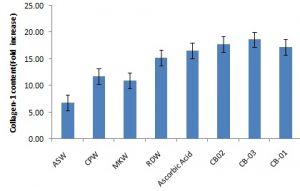
FIG. 2: ESTIMATION OF COLLAGEN-I IN INDIVIDUAL EXTRACTS AND POLYHERBAL BLENDS IN HDF CELLS BY ELISA KIT METHOD, DATA ARE REPRESENTED AS MEAN ± SEM (P ≤ 0.05) VS CONTROL)
Cytotoxicity Assay for Cream Formulation: The cream formulation without active blend was coded as (PHY/AAC/01), cream formulation containing poly-herbal blend (CB 03) was coded as (PHY/AAC/02) whereas the market sample was coded as (PHY/AAC/03) which were analyzed by MTT assay. The results as showed in Fig. 3 showed that increase in concentration up to 1000 μg/mL did not reduce the cell viabilities in all tested concentrations in NIH 3T3 cells. The percentage cyto-toxicity of (PHY/AAC/02) was 42.7 ± 0.18 at 1000 μg/mL at 24 hr, and the nontoxic concentration was taken for further study. This assay was performed to ascertain the safety aspects of formula before testing in human volunteers.
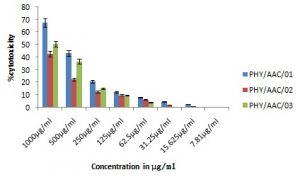
FIG. 3: ASSESSMENT OF CYTOTOXIC ACTIVITY OF PHY/AAC/01 (PLACEBO), PHY/AAC/02 (IN-HOUSE SAMPLE) AND PHY /AAC/03 (MARKET SAMPLE) USING NIH 3T3 CELL LINES. DATA ARE REPRESENTED AS MEAN ± SEM (P ≤ 0.05) VS CONTROL)
Collagen-1 ELISA for Cream Formulation and Collagen Gene I Expression Study: Cream formulation (placebo) (PHY/AAC/01) as shown in Fig. 4 showed 6.94 ± 1.65 ng/mL, Cream with poly herbal extract blend (CB 03) (PHY/AAC/02) showed 17.53 ± 0.011 ng/mL whereas market sample (PHY/AAC/03) showed 11.02 ± 0.015 ng/mL of Collagen–I content. The (PHY/AAC/02) showed 17.53 ± 0.011 ng/mL of collagen-I content as compared to 16.53 ± 0.064 ng/mL of standard Ascorbic acid (100µg/mL) which is marginally higher as compared to standard. The result was found to be statistically significant P ≤ 0.05.
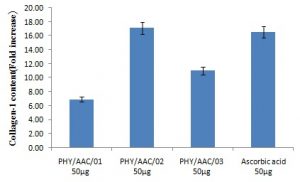
FIG. 4: COLLAGEN CONTENT DETERMINATION IN CREAM FORMULATIONS COMPARED TO STANDARD DATA ARE REPRESENTED AS MEAN ± SEM (P ≤ 0.05) VS CONTROL)
Collagen -1 expression study was carried out in HDF cells. RT-PCR profile of Collagen type-I and GAPDH gene was obtained in HDF cells treated with cream formulations containing (PHY/AAC /01), (PHY/AAC/02) and (PHY/AAC/03). The collagen-I gene expression in Fig. 5A and 5B showed increase in collagen content in the fibroblasts treated with (PHY/AAC/02) compared to market samples of (PHY/AAC/03) respectively.
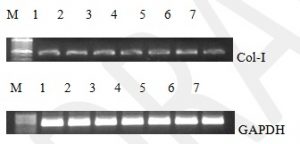
FIG. 5A: RT PCR PROFILE OF GENE TRANSCRIPTS RESOLVED IN 1.5% AGAROSE GEL
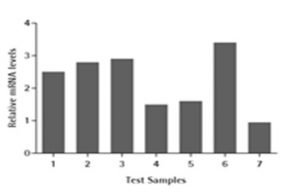
FIG. 5B: DENSITOMETRIC ANALYSIS OF GENE TRANSCRIPTS (M- MOLECULAR MARKER, 1- CELLS TREATED WITH PHY/AAC/001, 2- CELLS TREATED WITH PHY/AAC/02(50 µg/mL), 3- CELLS TREATED WITH PHY/AAC/02(100 µg/mL), 4- CELLS TREATED WITH PHY/AAC/03(50 µg/mL), 5- CELLS TREATED WITH PHY/AAC/03(100 µg/mL), 6- CELLS TREATED WITH ASCORBIC ACID-0.2MM, 7- CELL CONTROL)
Rheological Studies:
Flow curve measurements: The final product sample was analyzed for flow behavior in the shear rate range of 0.0 to 100 1/s, which helped observe the changes in viscosity of the sample as a function of shear at 25 °C (rotational mode). Shear thinning behavior was observed, and the results are shown in Fig. 6. This confirms (PHY/AAC/02) has good emulsion strength compared to (PHY/AAC/01) (placebo) and (PHY/AAC/03) (Market sample).
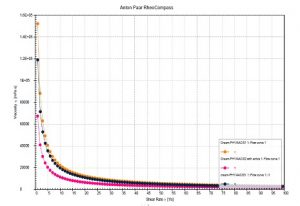
FIG. 6: FLOW CURVE MEASUREMENTS (SHEAR RATE VERSUS VISCOSITY)
Amplitude Sweep Measurement (Linear Viscoelastic Range): Amplitude sweep from 0.001 to 100% strain rate was performed at constant angular frequency of 10 rad/sec to determine the limit of linear viscoelastic (LVE) range. The results indicated that below this limiting value, G’ (elastic modulus) and G” (loss modulus) curves remained at a constant plateau that is the structure of the sample showed stable curve under this condition. In oscillatory mode, the amplitude sweep showed that the limit of the LVE range for cream (with active) was 10%, and without active was 4% whereas LVE for standard (market sample) was 3%. The amplitude sweep curve showed that G’ > G”, which implied that all the above samples (PHY/AAC/01), (PHY/AAC/02) and (PHY/AAC/03) have good cream strength. The results are shown in Fig 7.
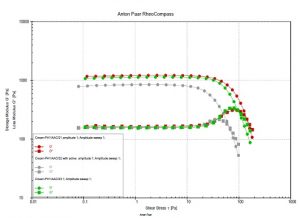
FIG. 7: AMPLITUDE SWEEP MEASUREMENT (LINEAR VISCOELASTIC RANGE) CURVES
Amplitude Sweep (Spreadability test): The temperature-dependent structural strength and spreadability tests were carried out for amplitude sweep in strain range of 0.001 to 100% with the constant angular frequency of 10 rad/sec at constant temperature 25 °C. In the LVE range (i.e, at very low deformations), all the samples were observed to show G¢> G², which indicates that elastic modulus is higher than viscous modulus (i.e., good cream strength of the samples). The G¢ curve showed that all the samples were spreading smoothly and consistently with same curve pattern, which approves its spreadability. The results are shown in Fig. 8 confirms excellent cream spreadability for placebo (PHY/AAC/01), (PHY/AAC/02) compared to market sample (PHY/AAC/03).
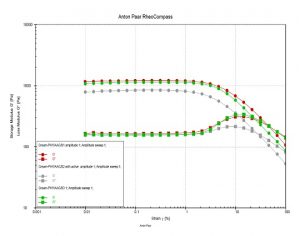
FIG. 8: AMPLITUDE SWEEP (SPREADIBILITY TEST) MEASUREMENTS
Thixotropic test: The thixotopic test was done under 3 intervals: The samples (PHY/AAC/01, PHY/AAC/02, and PHY/AAC/03 standard [market sample]) were analysed in shear rate ramp of 2 to 100 1/s for 165 seconds. In the second interval, the samples were analysed at constant shear of 100 1/s for 65 seconds. In the third interval, the samples were sheared down from 100 to 2 1/s shear rate. The cream samples were analysed for structure regeneration (area under the curve), which resulted in 265.9, 79.426 and 115.68of thixotropic index [Pa.S)]. The thixotropic results reconfirm the viscoelasticity and good emulsion strength for Cream (PHY/AAC/01) and (PHY/AAC/02) as compared to (PHY/AAC/03) which is shown in Fig. 9.
Stability Study: Temperature-dependent stability study was conducted on cream base formula -2 which was recoded as (PHY AAC).The same base was used in cream formula (PHY/AAC/01) without active blend and (PHY/AAC/02) with active blend to ensure the product’s internal structure and emulsion structure stability at 30 °C and 45 °C for minimum 3-month storage condition. Comparative data for Viscosity at real time and accelerated conditions as shown in Fig. 10 and 11 proves Polyherbal extract blend (CB 03) containing cream formulation (PHY/AAC/02) is significantly stable as compared to market sample (PHY/AAC/03) (p>0.05) for the period of 6 months.
The viscosity was found to be in range of 2, 03,000±1140.17cps and 2, 87,000±687.75 cps. The p value for (PHY/AAC/02) is ≤0.00001, the result was found to be statistically significant. The pH of real time and accelerated condition of Polyherbal blend (CB 03) containing cream formulation (PHY/AAC/02) was found to be much stable at real time and accelerated condition for period of 6 months as compared to market sample (PHY/AAC/03) as shown in Fig. 12 and 13. The p value for (PHY/AAC/02) was0.000982.The result was statistically significant at p<0.05 whereas market sample (p>0.05) therefore no statistical significantly effect found in market sample.
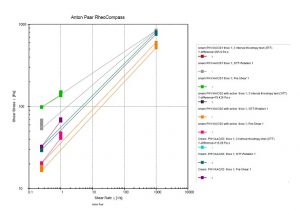
FIG. 9: THIXOTROPIC RESULTS FOR CREAM BASE PHYAAC/01 (PLACEBO), PHY/AAC/02 (WITH ACTIVE) AND PHY/AAC/03(MARKET SAMPLE)
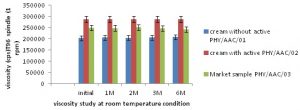
FIG. 10: VISCOSITY DETERMINATION AT REAL TIME CONDITIONS (30 °C AND 65% RH) VISCOSITY DETERMINATION FOR CREAM BASE(PLACEBO), WITH ACTIVE, AND MARKET SAMPLE (45 °C AND 75% RH) DATA EXPRESSED AS MEAN ± SEM n=3(p≤0.005)
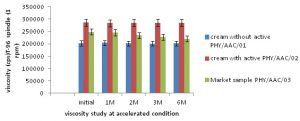
FIG. 11: VISCOSITY DETERMINATION AT ACCELERATED CONDITIONS FOR CREAM BASE (PLACEBO), WITH ACTIVE, AND MARKET SAMPLE (45 °C AND 75% RH) DATAVALUES EXPRESSED AS MEAN ± SEM n=3(p≤0.005)
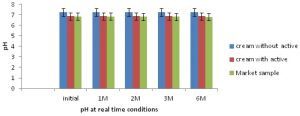
FIG. 12: pH DETERMINATION AT REAL-TIME STABILITY CONDITIONS (30 °C AND 65% RH) DATAVALUES EXPRESSED AS MEAN ± SEM n=3(p≤0.005)
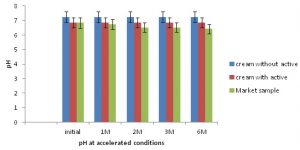
FIG. 13: pH DETERMINATION AT ACCELERATED STABILITY CONDITIONS (45 °C AND 75% RH). DATA EXPRESSED AS MEAN ± SEM n=3(p≤0.005)
CONCLUSION: The polyherbal cream was designed and optimized using suitable polymers and emulsifying agents. The extracts blend of (M. koengii extract, C. paniculatum extract, R. damascena extract and A. squamosa extract) helps to prevent skin dryness and rejuvenates the skin. The results showed better emulsion stability for (PHY/AAC/02) in both the real time and accelerated conditions. At all temperature conditions, the pH range was observed to be between 5.91 ±0.16 and 6.14± 0.01. The viscosity study (in cps) revealed the range to be between 2, 03,000±1140.17and 2, 87,000±687.75. The cream was found to be stable at accelerated stability conditions. The CTC50 value of the final cream base (with and without extract blend) was above 1000 μg/mL at 24 hours. The rheological studies based on thixotropic, amplitude, amplitude sweep and flow curve measurements showed that the cream formulation has excellent emulsion strength, viscoelasticity, shear thinning property and spreadability.
The results of collagen estimation highlighted the stimulation of collagen gene I expression in polyherbal extract (CB 03) containing cream (PHY/AAC/ 02) treated HDF cells. The article first time reports the polyherbal use of extract blend of four Indian plants on Human skin cells in vitro. The polyherbal extract blend, (CB 03) in cream formulation (PHY/AAC/02) act as skin protective anti-ageing herbal ingredient for building skin structural proteins targeting mainly collagen. The cream formula (PHY/AAC/02) with active blend (CB03) on topical application prevents damage of the skin by stimulating collagen synthesis. The increased collagen content in skin after regular cream application thereby proves the formation of collagen matrix and repairs the damaged skin for the different clinical conditions mainly for skin vitality and skin rejuvenation.
ACKNOWLEDGEMENT: The work was solely performed at the Himalaya Drug Company (Bangalore, India). I express my sincere gratitude to the Himalaya Drug Company for providing me the research facilities and financial support. I express my sincere gratitude to Dr. Rangesh Paramesh, (Chief Scientific Officer, R&D Center, The Himalaya Drug Company, India) for his extensive support. I would also like to convey my heartfelt thanks to Dr. Gopumadhavan (Principal Scientist, The Himalaya Drug Company, India) and Dr. Chandrika Mahendra (Senior research Scientist, The Himalaya Drug Company, India)for their extraordinary support.
DECLARATION OF INTEREST: The authors report no declarations of interest.
REFERENCES:
- Alfredo G, Müller BR, Dale I, Silva CG, Samuel NMR, Ferreira LM, and Brasileira AC: Keratinocyte growth factor, tumor necrosis factor-alpha and interleukin-1 beta gene expression in cultured fibroblasts and keratinocytes from burned patients. Acta Cirúrgica Brasileira.2013; 28(8): 551.
- Aurélie P, Emmanuelle M and Richard R: Aspects of Facial Contrast Decrease with Age and Are Cues for Age Perception. PLoS ONE 2013; 8(3): 1-8.
- Luebberding S, Krueger N and Kerscher M: Age-related changes in skin barrier function – Quantitative evaluation of 150 female subjects. International Journal of Cosmetic Science 2013; 35: 183–190.
- Silva MR, Celem LR, Silva SR and Costa APF: Anti-aging cosmetics: Facts and controversies. Clinics in Dermatology. 2013; 31, 6: 750-758.
- Majewska SM, Marcińska K, Maresz KZ, Szczepanik M : Epicutaneous Immunization with Collagen Induces TCR αβ Suppressor T Cells that Inhibit Collagen-Induced Arthritis. International Archives of Allergy and Immunology 2015; 166(2):121-34.
- Lee HY,Ghimeray AK, Yim JH, Chang MS: Antioxidant, Collagen Synthesis Activity in vitro and Clinical Test on Anti-Wrinkle activity of Formulated Cream Containing Veronica officinalis Journal of Cosmetics, Dermatological Sciences and Applications 2015; 5: 45-51.
- Shahram S: Medicinal Plants as Anti-Ageing Materials. A Review .Global Journal of Medicinal Plant Research 2013; 1(2): 234-236.
- Ghadir A, Chaghaby E, Abeer FA and Eman, SR: Evaluation of the antioxidant and antibacterial properties of various solvents extracts of Annona squamosa leaves Arabian Journal of Chemistry. 2014; 7, 2: 227-233.
- Thangavel P and Lonchin S: Efficacy of Annona squamosa L in the Synthesis of Glycosaminoglycans and Collagen during Wound Repair in Streptozotocin Induced Diabetic Rats. BioMed Research International. 2014; 1-10.
- Goyal AK, Pallab, K Das AP and Sen A: Antioxidant and pharmaceutical potential of Clerodendrum. International Journal of Green Pharmacy 2014: 2010-2016.
- Bindu N, Rajanna A, Anitha C, Balakrishna N, Raghunath M and Ayesha I: Murraya koenigii leaf extract inhibits proteasome activity and induces cell death in breast cancer cell. BMC Complementary and Alternative Medicine 2013; 13: 7: 1-17.
- Vasudevan M, Kalavathy R, Aliya A, Milind P, Syed AAS and Abu BAM: Protective effects of total alkaloidal extract from Murraya koenigii leaves on experimentally induced dementia. Food and Chemical Toxicology 2012; 50: 3–4: 1036-1044.
- Nilgün GB and Hasan B: Phenolic compounds, antiradical activity and antioxidant capacity of oil-bearing rose (Rosa damascena) extracts. Industrial Crops and Products 2013; 41:375-380.
- Boskabady MH, Naser MS, Zahra S and Somayeh A: Pharmacological Effects of Rosa Damascena. Iranian Journal of Basic Medical Sciences 2011; 14, 4: 295-307.
How to cite this article:
Krishnan RD, Kumar MV, Varma RS, Babu UV and Dhanabal SP: Design and development of polyherbal based cream formulation with anti-skin ageing benefits. Int J Pharm Sci Res 2017; 8(10): 4147-58.doi: 10.13040/IJPSR.0975-8232.8(10).4147-58.
All © 2013 are reserved by International Journal of Pharmaceutical Sciences and Research. This Journal licensed under a Creative Commons Attribution-NonCommercial-ShareAlike 3.0 Unported License.
Article Information
12
4147-4158
872
1634
English
IJPSR
R. D. Krishnan*, M. V. Kumar, R. S. Varma , U.V. Babu and S. P. Dhanabal
R & D Center, The Himalaya Drug Company, Makali, Bangalore, Karnataka, India.
dilmel.r@himalayawellness.com
22 February, 2017
24 April, 2017
27 May, 2017
10.13040/IJPSR.0975-8232.8(10).4147-58
01 October, 2017


